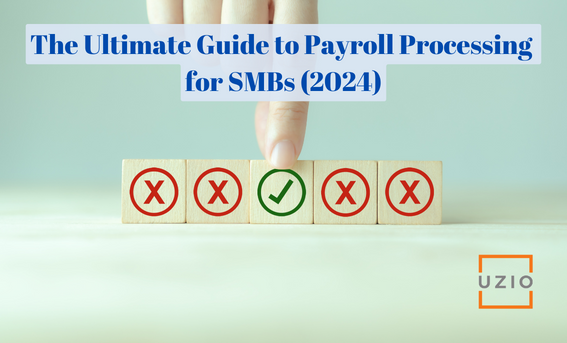
The Ultimate Guide to Payroll Processing for SMBs (2024)
Quick links
-
Introduction
-
Understanding Payroll: Basic Concepts and Definitions
-
Setting Up Your Payroll Process
-
Executing Payroll: A Step-By-Step Guide
-
UZIO: The Best All-in-One Payroll Solution for SMBs
-
Outsourcing Payroll: When and How to Hire a Professional
-
Payroll Management Best Practices
-
Common Payroll Challenges and Solutions
-
Payroll Costs and Budgeting
-
Payroll Compliance and Legal Considerations
-
Embracing Digital Solutions for Payroll Management
-
Payroll Resources and Support
-
Conclusion
Introduction
Welcome to our comprehensive guide on payroll processing for SMBs! Whether you’re a new business owner or looking to refine your payroll process, this guide is designed to walk you through every essential step, keeping your business running smoothly and compliantly.
1. Introduction to Payroll for SMB Owners
Payroll management is a crucial aspect of running a SMB. It involves more than just issuing paychecks; it’s about understanding legal requirements, managing employee information, and ensuring accurate and timely tax filings. Getting payroll right is vital for the health of your business and the satisfaction of your employees. For an in-depth look at the latest payroll innovations, check out UZIO’s December Product Release: Exciting New Features.
2. Understanding Payroll: Basic Concepts and Definitions
2.1. What Is Payroll Processing?
Payroll processing refers to the entire process of managing the payment of wages by a company to its employees. This involves tracking hours worked, calculating pay, deducting taxes, and ensuring timely disbursement of salaries.
2.2. Manual Processing vs. Using a Payroll Service
Deciding between manual payroll processing and using a service depends on your business size, complexity, and budget. Manual processing is more hands-on and cost-effective for very small businesses, while payroll services offer time-saving automation and compliance features. For a comparison of top payroll software solutions, visit our blog on Comparing Top Payroll Software Solutions for the Cannabis Industry.
3. Setting Up Your Payroll Process
3.1. Step 1: Establish Your Employer Identification Number (EIN)
Your EIN is like a Social Security number for your business. It’s required for reporting taxes to the IRS and for state payroll reports.
3.2. Step 2: Collect Employee Tax Information
Ensure all employees complete a W-4 form, which provides the necessary information to calculate withholding taxes. Learn more about the importance of proper documentation in our article on What Does a Pay Stub Look Like.
3.3. Step 3: Choose a Payroll Schedule
Decide how often you’ll pay your employees: weekly, biweekly, semimonthly, or monthly. Each has its own advantages and impacts on cash flow and payroll processing.
3.4. Step 4: Understand and Comply with Overtime Regulations
Familiarize yourself with the Fair Labor Standards Act (FLSA) to properly compensate eligible employees for overtime. For more insights, see our guide on List of 2024 Federal Holidays for Small Businesses That You Need to Know.
4. Executing Payroll: A Step-By-Step Guide
Step 1: Review and Approve Time Sheets
Carefully check time records for accuracy. Inaccurate timekeeping can lead to payroll errors.
Step 2: Calculate Gross Pay
Determine the total pay owed to each employee before deductions based on their hours worked and pay rate.
Step 3: Calculate and Withhold Income Taxes
Use each employee’s W-4 and IRS tables to calculate federal income tax withholding, along with state and local taxes where applicable.
Step 4: Determine Other Deductions
Include deductions like retirement plan contributions, health insurance premiums, and wage garnishments if applicable. For a deeper understanding of benefits in the cannabis industry, see our blog on 401k Plans in the Cannabis Industry.
Step 5: Calculate Net Pay and Pay Employees
Subtract taxes and other deductions from gross pay to determine each employee’s net pay. Then, issue payments via check, direct deposit, or other agreed-upon methods.
Step 6: File and Report Payroll Taxes
Regularly file all required payroll tax forms with the IRS and your state tax agency.
Step 7: Store and Maintain Payroll Records
Keep detailed records of your payroll process, including time sheets, tax filings, and proof of payments, typically for at least three years.
5. UZIO: The Best All-in-One Payroll Solution for SMBs
5.1. Why Choose UZIO for Your Payroll Needs?
UZIO is a leading SaaS-based payroll software provider, offering a comprehensive all-in-one payroll, HRIS, and benefits solution specifically designed for SMBs. With UZIO, you can automate and streamline your payroll process, ensuring accuracy, compliance, and efficiency. Learn about UZIO’s exciting features in our October Product Release.
5.2. Integrating Payroll, HRIS, and Benefits Seamlessly with UZIO
UZIO simplifies payroll management by integrating it with HR and benefits administration. This integration offers a unified platform for managing all aspects of employee compensation and benefits, reducing administrative burdens and improving overall workflow efficiency. Discover how UZIO can enhance employee retention through payroll software in our blog Enhancing Employee Retention Through Payroll Software.
Recommended Reading: Biggest pain point with Payroll and HR software
6. Outsourcing Payroll: When and How to Hire a Professional
6.1. Benefits of Hiring a Payroll Specialist or Company
Outsourcing payroll to a specialist can save you time, reduce the risk of errors, and ensure compliance with changing tax laws and regulations. For more on this topic, check out Why Switching Payroll Providers in The Fourth Quarter Makes Perfect Sense.
6.2. Steps for Outsourcing Your Payroll
Select a reputable payroll provider, set up your account with employee and company information, and transition your payroll process to the provider.
7. Payroll Management Best Practices
7.1. Designing Effective Payroll Policies
Create clear payroll policies covering aspects like pay periods, overtime, leave, and bonuses to ensure transparency and consistency.
7.2. Classifying Workers Correctly
Correctly classify employees as either full-time, part-time, or independent contractors to comply with labor and tax laws.
7.3. Tracking and Documenting Employee Pay Accurately
Maintain meticulous records of hours worked, wages paid, and deductions made for each employee.
8. Common Payroll Challenges and Solutions
8.1. Frequent Payroll Mistakes and How to Avoid Them
Understand common payroll mistakes, like misclassifying employees or miscalculating overtime, and implement checks and balances to prevent them.
8.2. Correcting Payroll Errors
Develop a process for quickly and accurately correcting payroll errors when they occur.
8.3. Managing Payroll during Employee Leave and Holidays
Familiarize yourself with the rules regarding paid and unpaid leave to ensure proper payroll adjustments.
9. Payroll Costs and Budgeting
9.1. Understanding Payroll Processing Costs and Fees
Be aware of the costs associated with different payroll processing methods, including software subscriptions and outsourcing fees.
9.2. Reducing Payroll Costs without Compromising Efficiency
Explore strategies to reduce payroll costs, such as leveraging technology or adjusting payroll schedules, without impacting employee satisfaction or legal compliance.
10. Payroll Compliance and Legal Considerations
10.1. Tax and Social Security Obligations
Understand your obligations for withholding and paying federal and state taxes, as well as Social Security and Medicare contributions.
10.2. Employer Contributions for Social Security and Medicare (FICA)
Ensure accurate calculation and timely payment of FICA taxes to avoid penalties.
10.3. Adhering to Federal and State Payroll Tax Laws
Stay informed about the latest federal and state payroll tax laws to maintain compliance and avoid costly fines.
11. Embracing Digital Solutions for Payroll Management
11.1. Security and Privacy in Online Payroll Processing
Implement robust security measures to protect sensitive payroll data from cyber threats and ensure privacy compliance.
12. Payroll Resources and Support
12.1. Helpful Tools and Software Recommendations
Recommendations for tools and software that can simplify the payroll process and improve accuracy.
12.2. Where to Find Professional Payroll Advice
Resources for professional advice, including payroll consultants, online forums, and professional organizations.
13. Conclusion: Streamlining Your Payroll Process
In conclusion, effective payroll management is a cornerstone of a successful small business. By understanding the essentials and leveraging tools like UZIO, you can ensure a smooth, compliant, and efficient payroll process.
Get in touch with us for an expert-led demo to know more about UZIO all-in-one payroll software.





